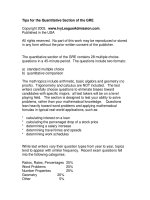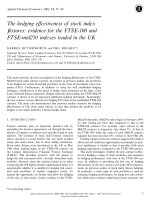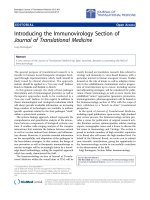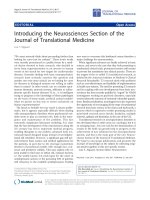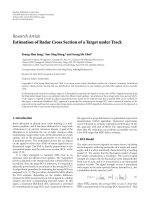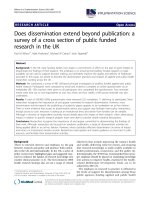Empirical asset pricing the cross section of stock returns
Bạn đang xem bản rút gọn của tài liệu. Xem và tải ngay bản đầy đủ của tài liệu tại đây (3.29 MB, 515 trang )
EMPIRICAL ASSET
PRICING
EMPIRICAL ASSET
PRICING
The Cross Section of Stock Returns
TURAN G. BALI
ROBERT F. ENGLE
SCOTT MURRAY
Copyright © 2016 by John Wiley & Sons, Inc. All rights reserved
Published by John Wiley & Sons, Inc., Hoboken, New Jersey
Published simultaneously in Canada
No part of this publication may be reproduced, stored in a retrieval system, or transmitted in any form or
by any means, electronic, mechanical, photocopying, recording, scanning, or otherwise, except as
permitted under Section 107 or 108 of the 1976 United States Copyright Act, without either the prior
written permission of the Publisher, or authorization through payment of the appropriate per-copy fee to
the Copyright Clearance Center, Inc., 222 Rosewood Drive, Danvers, MA 01923, (978) 750-8400, fax
(978) 750-4470, or on the web at www.copyright.com. Requests to the Publisher for permission should
be addressed to the Permissions Department, John Wiley & Sons, Inc., 111 River Street, Hoboken, NJ
07030, (201) 748-6011, fax (201) 748-6008, or online at />Limit of Liability/Disclaimer of Warranty: While the publisher and author have used their best efforts in
preparing this book, they make no representations or warranties with respect to the accuracy or
completeness of the contents of this book and specifically disclaim any implied warranties of
merchantability or fitness for a particular purpose. No warranty may be created or extended by sales
representatives or written sales materials. The advice and strategies contained herein may not be suitable
for your situation. You should consult with a professional where appropriate. Neither the publisher nor
author shall be liable for any loss of profit or any other commercial damages, including but not limited to
special, incidental, consequential, or other damages.
For general information on our other products and services or for technical support, please contact our
Customer Care Department within the United States at (800) 762-2974, outside the United States at
(317) 572-3993 or fax (317) 572-4002.
Wiley also publishes its books in a variety of electronic formats. Some content that appears in print may
not be available in electronic formats. For more information about Wiley products, visit our web site at
www.wiley.com.
Library of Congress Cataloging-in-Publication Data
Names: Bali, Turan G., author. | Engle, R. F. (Robert F.) author. | Murray,
Scott, 1979- author.
Title: Empirical asset pricing : the cross section of stock returns / Turan
G. Bali, Robert F. Engle, Scott Murray.
Description: Hoboken : Wiley, 2016. | Includes bibliographical references and
index.
Identifiers: LCCN 2015036767 (print) | LCCN 2016003455 (ebook) | ISBN
9781118095041 (hardback) | ISBN 9781118589663 (ePub) | ISBN 9781118589472
(Adobe PDF)
Subjects: LCSH: Stocks–Prices. | Rate of return. | Stock exchanges. | BISAC:
BUSINESS & ECONOMICS / Finance.
Classification: LCC HG4636 .B35 2016 (print) | LCC HG4636 (ebook) | DDC
332.63/221–dc23
LC record available at />Typeset in 10/12pt TimesLTStd by SPi Global, Chennai, India
Printed in the United States of America
10 9 8 7 6 5 4 3 2 1
“The empirical analysis of the cross section of stock returns is a monumental achievement of half a century of finance research. Both the established facts and the methods
used to discover them have subtle complexities that can mislead casual observers and
novice researchers. Bali, Engle, and Murray’s clear and careful guide to these issues
provides a firm foundation for future discoveries.”
John Campbell, Morton L. and Carole S. Olshan Professor of Economics, Harvard
University
“Bali, Engle, and Murray have produced a highly accessible introduction to the techniques and evidence of modern empirical asset pricing. This book should be read and
absorbed by every serious student of the field, academic and professional.”
Eugene Fama, Robert R. McCormick Distinguished Service Professor of Finance,
University of Chicago
“Bali, Engle, and Murray provide clear and accessible descriptions of many of the most
important empirical techniques and results in asset pricing.”
Kenneth R. French, Roth Family Distinguished Professor of Finance, Tuck School of
Business, Dartmouth College
“This exciting new book presents a thorough review of what we know about the
cross section of stock returns. Given its comprehensive nature, systematic approach,
and easy-to-understand language, the book is a valuable resource for any introductory
PhD class in empirical asset pricing.”
Lubos Pastor, Charles P. McQuaid Professor of Finance, University of Chicago
CONTENTS
PREFACE
PART I
1
xv
STATISTICAL METHODOLOGIES
Preliminaries
1.1
1.2
1.3
1.4
2.2
2.3
9
Implementation, 10
2.1.1 Periodic Cross-Sectional Summary Statistics, 10
2.1.2 Average Cross-Sectional Summary Statistics, 12
Presentation and Interpretation, 12
Summary, 16
3 Correlation
3.1
3
Sample, 3
Winsorization and Truncation, 5
Newey and West (1987) Adjustment, 6
Summary, 8
References, 8
2 Summary Statistics
2.1
1
Implementation, 18
3.1.1 Periodic Cross-Sectional Correlations, 18
3.1.2 Average Cross-Sectional Correlations, 19
17
viii
CONTENTS
3.2
3.3
3.4
Interpreting Correlations, 20
Presenting Correlations, 23
Summary, 24
References, 24
4 Persistence Analysis
4.1
4.2
4.3
4.4
Implementation, 26
4.1.1 Periodic Cross-Sectional Persistence, 26
4.1.2 Average Cross-Sectional Persistence, 28
Interpreting Persistence, 28
Presenting Persistence, 31
Summary, 32
References, 32
5 Portfolio Analysis
5.1
5.2
5.3
5.4
5.5
5.6
25
Univariate Portfolio Analysis, 34
5.1.1 Breakpoints, 34
5.1.2 Portfolio Formation, 37
5.1.3 Average Portfolio Values, 39
5.1.4 Summarizing the Results, 41
5.1.5 Interpreting the Results, 43
5.1.6 Presenting the Results, 45
5.1.7 Analyzing Returns, 47
Bivariate Independent-Sort Analysis, 52
5.2.1 Breakpoints, 52
5.2.2 Portfolio Formation, 54
5.2.3 Average Portfolio Values, 57
5.2.4 Summarizing the Results, 60
5.2.5 Interpreting the Results, 64
5.2.6 Presenting the Results, 66
Bivariate Dependent-Sort Analysis, 71
5.3.1 Breakpoints, 71
5.3.2 Portfolio Formation, 74
5.3.3 Average Portfolio Values, 76
5.3.4 Summarizing the Results, 80
5.3.5 Interpreting the Results, 80
5.3.6 Presenting the Results, 81
Independent Versus Dependent Sort, 85
Trivariate-Sort Analysis, 87
Summary, 87
References, 88
33
ix
CONTENTS
6 Fama and Macbeth Regression Analysis
6.1
6.2
6.3
6.4
PART II
Implementation, 90
6.1.1 Periodic Cross-Sectional Regressions, 90
6.1.2 Average Cross-Sectional Regression Results, 91
Interpreting FM Regressions, 95
Presenting FM Regressions, 98
Summary, 99
References, 99
THE CROSS SECTION OF STOCK RETURNS
7 The CRSP Sample and Market Factor
7.1
7.2
7.3
7.4
7.5
8.6
103
122
Estimating Beta, 123
Summary Statistics, 126
Correlations, 128
Persistence, 129
Beta and Stock Returns, 131
8.5.1 Portfolio Analysis, 132
8.5.2 Fama–MacBeth Regression Analysis, 140
Summary, 143
References, 144
9 The Size Effect
9.1
9.2
9.3
9.4
9.5
101
The U.S. Stock Market, 103
7.1.1 The CRSP U.S.-Based Common Stock Sample, 104
7.1.2 Composition of the CRSP Sample, 105
Stock Returns and Excess Returns, 111
7.2.1 CRSP Sample (1963–2012), 115
The Market Factor, 115
The CAPM Risk Model, 120
Summary, 120
References, 121
8 Beta
8.1
8.2
8.3
8.4
8.5
89
Calculating Market Capitalization, 147
Summary Statistics, 150
Correlations, 152
Persistence, 154
Size and Stock Returns, 155
9.5.1 Univariate Portfolio Analysis, 155
146
x
CONTENTS
9.6
9.7
10
9.5.2 Bivariate Portfolio Analysis, 162
9.5.3 Fama–MacBeth Regression Analysis, 168
The Size Factor, 171
Summary, 173
References, 174
The Value Premium
175
10.1
10.2
10.3
10.4
10.5
Calculating Book-to-Market Ratio, 177
Summary Statistics, 181
Correlations, 183
Persistence, 184
Book-to-Market Ratio and Stock Returns, 185
10.5.1 Univariate Portfolio Analysis, 185
10.5.2 Bivariate Portfolio Analysis, 190
10.5.3 Fama–MacBeth Regression Analysis, 198
10.6 The Value Factor, 200
10.7 The Fama and French Three-Factor Model, 202
10.8 Summary, 203
References, 203
11
The Momentum Effect
206
11.1
11.2
11.3
11.4
Measuring Momentum, 207
Summary Statistics, 208
Correlations, 210
Momentum and Stock Returns, 211
11.4.1 Univariate Portfolio Analysis, 211
11.4.2 Bivariate Portfolio Analysis, 220
11.4.3 Fama–MacBeth Regression Analysis, 234
11.5 The Momentum Factor, 236
11.6 The Fama, French, and Carhart Four-Factor Model, 238
11.7 Summary, 239
References, 239
12
Short-Term Reversal
12.1
12.2
12.3
12.4
Measuring Short-Term Reversal, 243
Summary Statistics, 243
Correlations, 243
Reversal and Stock Returns, 244
12.4.1 Univariate Portfolio Analysis, 244
12.4.2 Bivariate Portfolio Analyses, 249
12.5 Fama–MacBeth Regressions, 263
242
CONTENTS
xi
12.6 The Reversal Factor, 268
12.7 Summary, 270
References, 271
13
Liquidity
272
13.1
13.2
13.3
13.4
13.5
Measuring Liquidity, 274
Summary Statistics, 276
Correlations, 277
Persistence, 280
Liquidity and Stock Returns, 281
13.5.1 Univariate Portfolio Analysis, 281
13.5.2 Bivariate Portfolio Analysis, 288
13.5.3 Fama–MacBeth Regression Analysis, 300
13.6 Liquidity Factors, 308
13.6.1 Stock-Level Liquidity, 309
13.6.2 Aggregate Liquidity, 310
13.6.3 Liquidity Innovations, 312
13.6.4 Traded Liquidity Factor, 312
13.7 Summary, 316
References, 316
14
Skewness
14.1 Measuring Skewness, 321
14.2 Summary Statistics, 323
14.3 Correlations, 326
14.3.1 Total Skewness, 326
14.3.2 Co-Skewness, 329
14.3.3 Idiosyncratic Skewness, 330
14.3.4 Total Skewness, Co-Skewness, and Idiosyncratic
Skewness, 331
14.3.5 Skewness and Other Variables, 333
14.4 Persistence, 336
14.4.1 Total Skewness, 336
14.4.2 Co-Skewness, 338
14.4.3 Idiosyncratic Skewness, 339
14.5 Skewness and Stock Returns, 341
14.5.1 Univariate Portfolio Analysis, 341
14.5.2 Fama–MacBeth Regressions, 350
14.6 Summary, 359
References, 360
319
xii
15
CONTENTS
Idiosyncratic Volatility
363
15.1
15.2
15.3
15.4
15.5
15.6
Measuring Total Volatility, 365
Measuring Idiosyncratic Volatility, 366
Summary Statistics, 367
Correlations, 370
Persistence, 380
Idiosyncratic Volatility and Stock Returns, 381
15.6.1 Univariate Portfolio Analysis, 382
15.6.2 Bivariate Portfolio Analysis, 389
15.6.3 Fama–MacBeth Regression Analysis, 402
15.6.4 Cumulative Returns of IdioVolFF,1M Portfolio, 407
15.7 Summary, 409
References, 410
16
Liquid Samples
412
16.1 Samples, 413
16.2 Summary Statistics, 414
16.3 Correlations, 418
16.3.1 CRSP Sample and Price Sample, 418
16.3.2 Price Sample and Size Sample, 420
16.4 Persistence, 421
16.5 Expected Stock Returns, 424
16.5.1 Univariate Portfolio Analysis, 425
16.5.2 Fama–MacBeth Regression Analysis, 435
16.6 Summary, 438
References, 439
17
Option-Implied Volatility
17.1 Options Sample, 443
17.2 Option-Based Variables, 444
17.2.1 Predictive Variables, 444
17.2.2 Option Returns, 447
17.2.3 Additional Notes, 448
17.3 Summary Statistics, 449
17.4 Correlations, 451
17.5 Persistence, 453
17.6 Stock Returns, 455
17.6.1 IVolSpread, IVolSkew, and Vol1M − IVol, 456
17.6.2 ΔIVolC and ΔIVolP, 460
17.7 Option Returns, 469
17.8 Summary, 474
References, 474
441
xiii
CONTENTS
18
Other Stock Return Predictors
18.1
18.2
18.3
18.4
18.5
18.6
INDEX
477
Asset Growth, 478
Investor Sentiment, 479
Investor Attention, 481
Differences of Opinion, 482
Profitability and Investment, 482
Lottery Demand, 483
References, 484
489
PREFACE
The objective of this book is to provide an overview of the empirical research on the
cross-section of expected stock returns. The book is intended for use in doctoral-level
empirical asset pricing classes and by investors who are looking for a review of the
most important predictors of future stock returns. A doctoral student reader should
come away with a solid understanding of the most fundamental results in the field
and a strong base upon which to pursue future research in empirical asset pricing. For
the reader whose intention is to apply the results presented in this book to practice,
our hope is that the book provides a basis upon which investment strategies can be
constructed as well as a strong understanding of the most prevalent patterns of risk
and returns in the cross-section of stocks.
It is assumed that the reader of this book has at least an MBA level understanding of theoretical asset pricing and a solid grasp of basic econometric techniques.
Fantastic books on these topics have been written by Cochrane (2005), Campbell, Lo,
and MacKinlay (1996), and Elton, Gruber, Brown, and Goetzmann (2014).1 More
in-depth knowledge in either of these areas is obviously a benefit. While all of the
analyses in this book are statistical in nature, the book is not designed to be an econometrics or statistics reference. Our discussions of statistical concepts, therefore, will
1 Several
other books have been written on related topics. Ang (2014) gives an in-depth insight into factor
investing. Factor analysis plays a large role in the empirical asset pricing literature and is used heavily
throughout this book. Karolyi (2015) gives a comprehensive exposition of risks associated with investing in
emerging markets. Pedersen (2015) provides a strong introduction into the trading strategies used by hedge
funds, many of which have their roots in the phenomena documented throughout this book. Campbell
(2015) provides a theoretical and empirical overview of empirical asset pricing research.
xvi
PREFACE
be primarily conceptual. For a more detailed discussion of the statistical theory underlying our methodologies, we suggest that the reader find an econometrics or statistics
text appropriate for the reader’s level of knowledge in this area.
This book is divided into two main parts. Part I is devoted to a discussion of the
most widely used statistical methodologies in empirical asset pricing research. The
objective of this section is to give readers a detailed understanding of how to conduct
such analyses and how to interpret the results. In addition, we discuss how the results
are summarized and presented in academic research articles. The techniques can, very
generally, be separated into two groups. Techniques in the first group are designed to
summarize the data upon which the research is based. Techniques in the second group
are designed to assess relations between the variables used in a study. These are the
tools used to investigate the cross-sectional relations between a set of variables and
future stock returns. Analysis of such relations is the primary objective of this book
and, more generally, the majority of empirical asset pricing research. That being said,
these techniques can be used for other purposes as well.
The second, and by far most important, part of this book discusses the major findings in empirical asset pricing research. In presenting each of the findings, we begin
by discussing in detail the calculation of the main variables used to capture the characteristic of the stock that is under investigation. We then apply the techniques discussed
in Part I, with the main objective being to understand the relation between the characteristic being examined and expected stock returns. While there are literally hundreds
of different variables that have been shown to be related to future stock returns, we
focus on the most widely recognized and cited phenomena in the literature.
We would like to acknowledge substantial support from our colleagues at Georgetown University, Georgia State University, and New York University. We would
like to specifically thank Viral Acharya, Vikas Agarwal, Yakov Amihud, Andrew
Ang, Gurdip Bakshi, Hank Bessembinder, Jacob Boudoukh, Brian Boyer, Stephen
Brown, Nusret Cakici, Fousseni Chabi-Yo, Peter Christoffersen, Martijn Cremers,
Ozgur Demirtas, Elroy Dimson, Rory Ernst, Wayne Ferson, Fangjian Fu, Thomas
Gilbert, Hui Guo, Umit Gurun, Cam Harvey, Bing Han, David Hirshleifer, Armen
Hovakimian, Kris Jacobs, Andrew Karolyi, Haim Kassa, Haim Levy, Jonathan
Lewellen, Lasse Pedersen, Lin Peng, Jeff Pontiff, Anna Scherbina, Rob Schoen,
Robert Stambaugh, Avanidhar Subrahmanyam, Yi Tang, Raman Uppal, Grigory
Vilkov, David Weinbaum, Robert Whitelaw, Liuren Wu, Yuhang Xing, Jianfeng Yu,
Lu Zhang, Xiaoyan Zhang, Guofu Zhou, and Hao Zhou for their valuable feedback
on both this book and on our previous research that has informed its writing.
Your input has substantially improved the quality of this book. We are especially
grateful to John Campbell, Gene Fama, Kenneth French, and Lubos Pastor for their
meticulous reading and detailed feedback, as well as for writing valuable reviews
of our book. The creation of this book would not have been possible without the
help of Sari Friedman, Jon Gurstelle, Saleem Hameed, and Steve Quigley at Wiley
and Sons, Inc. The efficiency and skill with which they executed all facets of the
production of this book far surpassed any reasonable expectations. Finally, we would
like to thank our wives and children, Marianne, Jordan, Lindsay, Mehtap, Kaan, and
Dara, for their unwavering support. Your love, encouragement, and tolerance played
PREFACE
xvii
an integral role in our ability to produce Empirical Asset Pricing: The Cross Section
of Stock Returns.
Turan G. Bali, Robert F. Engle, and Scott Murray New York, 2016.
REFERENCES
Ang, A. Asset Management A Systematic Approach to Factor Investing. Oxford University
Press, Oxford, 2014.
Campbell, J. Y. Financial Decisions and Markets. Princeton University Press, Princeton, NJ,
2015, manuscript in preparation.
Campbell, J. Y., Lo, A. W., and MacKinlay, A. C. The Econometrics of Financial Markets.
Princeton University Press, Princeton, NJ, 1996.
Cochrane, J. H. Asset Pricing. Princeton University Press, Princeton, NJ, 2005.
Elton, E. J., Gruber, M. J., Brown, S. J., and Goetzmann, W. N. Modern Portfolio Theory and
Investment Analysis. John Wiley & Sons, Hoboken, NJ, 9th Edition, 2014.
Karolyi, G. A. Cracking the Emerging Markets Enigma. Oxford University Press, Oxford,
2015.
Pedersen, L. H. Effficiently Inefficient: How Smart Money Invests & Market Prices Are Determined. Princeton University Press, Princeton, NJ, 2015.
PART I
STATISTICAL METHODOLOGIES
1
PRELIMINARIES
In this chapter, we present a number of items that are essential components of the
methodologies presented in (Part I) of this book. We present these elements here for
several reasons. First, they are common to many of the different analyses that will
be discussed. Second, being that they are common to many of the methodologies,
there is no one logical alternative as to where to present this material. Thus, to avoid
repetition, we present these items here and will assume them to be understood for the
remainder of the book.
Specifically, in this chapter, we first introduce the type of sample, or data, required
for each of the analyses presented in this part. We then discuss winsorization, a
technique that is used to adjust data, in order to minimize the effect of outliers on statistical analyses. Finally, we explain Newey and West (1987)-adjusted standard errors,
t-statistics, and p-values, which are commonly used to avoid problems with statistical
inference associated with heteroscedasticity and autocorrelation in time-series data.
1.1
SAMPLE
Each of the statistical methodologies presented and used in this book is performed
on a panel of data. Each entry in the panel corresponds to a particular combination
of entity and time period. The entities are referred to using i and the time periods are
referenced using t. In most asset pricing studies, the entities correspond to stocks,
Empirical Asset Pricing: The Cross Section of Stock Returns, First Edition.
Turan G. Bali, Robert F. Engle, and Scott Murray.
© 2016 John Wiley & Sons, Inc. Published 2016 by John Wiley & Sons, Inc.
4
PRELIMINARIES
bonds, options, or firms. The time periods used in most studies are months, weeks,
quarters, years, and in some cases days. Frequently, the data corresponding to any
given time period are referred to as a cross section. Thus, for a fixed value of t, the set
of entities i for which data are available in the given time period t is the cross section
of entities in time t. In almost all cases, the sample is not a full panel, meaning that
the set of entities included in the sample varies from time period to time period. For
each entity and time period combination (i, t), the data include several variables. In
general, the variable X for entity i during period t will be referred to as Xi,t . It is
frequently the case that when the data contain more than one variable, for example,
X and Y, for a given observation i, t, the value of Xi,t is available but the value of Yi,t
is not available. When this is the case, analyses that require values of both X and Y
will not make use of the data point i, t. Most studies create their sample such that the
main sample includes all data points for which values of the focal variables of the
study are available. Analyses that use nonfocal or control variables will then use only
the subset of observations for which the necessary data exist. This approach allows
each analysis to be applied to the largest data set for which the required variables
are available. However, in some cases, researchers prefer to restrict the sample used
for all analyses to only those observations where valid values of each variable used
in the entire study are available. The downside of this approach is that frequently a
large number of observations are lost. The upside is that all analyses are performed
on an identical sample, thus negating concerns related to the use of different data sets
for each of the analyses.
In the remaining chapters of Part I, we will use a sample where each entity i corresponds to a stock and each time period t corresponds to a year. The sample covers
a period of 25 years from 1988 through 2012 inclusive. For each year t, the sample
includes all stocks i in the Center for Research in Security Prices (CRSP) database
that are listed as U.S.-based common stocks on December 31 of the year t. Exactly
how to determine which stocks are U.S.-based common stocks will be discussed later
in the book. At this point, it suffices to say that the sample for each year t consists of
U.S. common stocks that were traded on exchanges as of the end of the given year.
We will use this sample to exemplify each of the methodologies that are discussed in
the remainder of Part I. We use a short sample period and annual periodicity because
having a small number of periods in the sample will facilitate presentation of the
methodologies. We refer to this sample as the methodologies sample. In Part II of
this book, which is devoted to the presentation of the main results in the empirical
asset pricing literature, we use monthly data covering a much longer sample period.
For each observation in the methodologies sample, we calculate five variables.
We should remind the reader that in many cases, one or more of the variables may
be unavailable or missing for certain observations. This is one of the realities under
which empirical asset pricing research is conducted. Here, we briefly describe these
variables. Detailed discussions of exactly how these variables are calculated will be
presented in later chapters.
We calculate the beta (𝛽) of stock i in year t as the slope coefficient from a regression of the excess returns of the stock on the excess returns of the market portfolio
using daily stock return data from all days during year t. We require a minimum
of 200 days worth of valid daily return data to calculate 𝛽. Values of 𝛽 for which
WINSORIZATION AND TRUNCATION
5
this criterion is not met are considered missing.1 We define the market capitalization
(MktCap) for stock i in year t as the number of shares outstanding times the price of
the stock at the end of year t divided by one million. Thus, MktCap is measured in
millions of dollars. We take Size to be the natural log of MktCap. As will be discussed
in Chapter 2, the distribution of MktCap is highly skewed; thus, most researchers use
Size instead of MktCap to measure the size of a firm.2 The book-to-market ratio (BM)
of a stock is calculated as the book value of the firm’s equity divided by the market
value of the firm’s equity (MktCap).3 Finally, the excess return of stock i in year t is
calculated as the return of stock i in year t minus the return of the risk-free security
in year t. All returns are recorded as percentages; thus, a value of 1.00 corresponds to
a 1% return. Stock return, price, and shares outstanding data come from CRSP. The
data used to calculate the book value of equity come from the Compustat database.
Risk-free security return data come from Kenneth French’s data library.4
1.2
WINSORIZATION AND TRUNCATION
Financial data are notoriously subject to outliers (extreme data points). In many statistical analyses, such data points may exert an undue influence on the results, making
the results unreliable. Thus, if these outliers are not adjusted or accounted for, it is possible that they may lead to a failure to detect a phenomenon that does exist (a type II
error), or even worse, results that indicate a phenomenon where no such phenomenon
is actually present (a type I error). While there are several statistical methods that are
designed to assess the effect of outliers or ameliorate their effect on results, empirical asset pricing researchers usually take a more ad hoc approach to dealing with the
effect of outliers.
There are two techniques that are commonly used in empirical asset pricing
research to deal with the effect of outliers. The first technique, known as winsorization, simply sets the values of a given variable that are above or below a certain cutoff
to that cutoff. The second technique, known as truncation, simply takes values of a
given variable that are deemed extreme to be missing. We discuss each technique in
detail. In doing so, we assume that we are dealing with a variable X for which there
are n different observations, which we denote X1 , X2 , … , Xn .
Winsorization is performed by setting the values of X that are in the top h percent
of all values of X to the 100-hth percentile of X. Similarly, values of X in the bottom l
percent of X values are set to the lth percentile of X. For example, assume that we want
to winsorize X on the high end at the 0.5% level (h = 0.5). We begin by calculating
the 99.5th percentile of the values of X. We denote this value Pctl99.5 (X). Then, we
set all values of X that are higher than Pctl99.5 (X) to Pctl99.5 (X). Now, assume that
we want to winsorize X on the low end at the 1.0% level (l = 1.0). This is done by
details of the calculation of 𝛽 are discussed in Chapter 8.
details of the calculation of MktCap and Size are discussed in Chapter 9.
3 The details of the calculation of BM are discussed in Chapter 10.
4 Kenneth French’s data library is found at />library.html.
1 The
2 The

